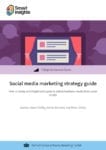Take a look at what we believe are the key social media marketing trends for 2020 that marketers need to be aware of in order to ensure their marketing strategy is up-to-date and as effective as possible.
Social media has now become synonymous with digital marketing, going hand-in-hand with most – if not all – digital campaigns. However, social media is far from static and what worked a few months ago may not get you the same good results now.
Habits change, platforms evolve, and new platforms come into existence. All of this influences how people use and react to social media marketing, as well as how marketers are able to reach their audience.
It is more important than ever before for marketers to understand and stay ahead of the curve when it comes to social media. Doing so ensures you have the right tools at your disposal, an up-to-date strategy, and the required skills to make the most of social media.
With this in mind, we’ve taken a look at some of the trends that we believe are going to be important when it comes to social media marketing in 2020. Here are the trends that we, and other experts, think you need to be aware of ahead of the new year:
The digital detox
There are now 3.484 billion social media users across the globe, which is a 9% increase compared to last year. This equates to 45% of the world’s population being on social media. It also means that social media adoption has actually beaten previous estimates, which suggested that an estimated 2.82 billion would be using social media in 2019. While this suggests that brands have the opportunity to reach larger audiences than ever before, a new trend is affecting that audience base.
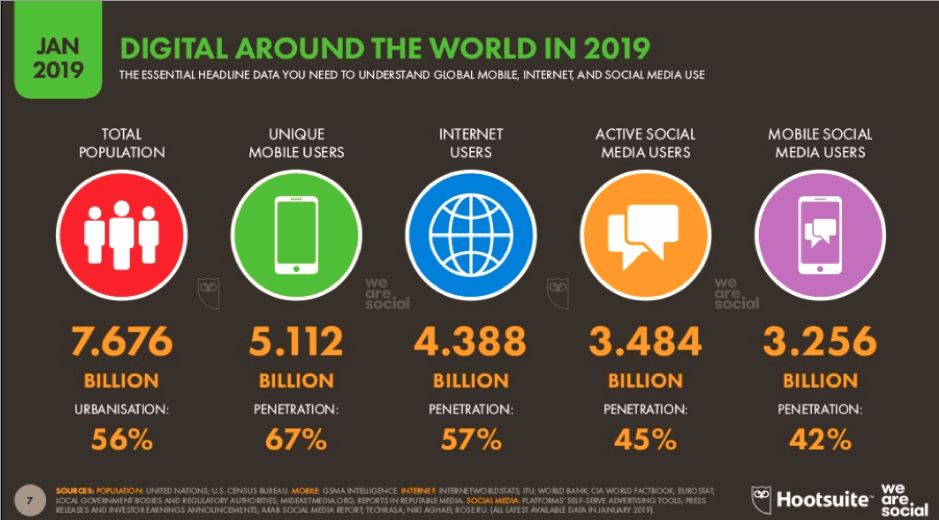
More people are now choosing to “detox” from social media, deleting apps and profiles in order to step away from it. This is more than just the usual changes we see in terms of people choosing to use one platform less in favour of another – such as Facebook seeing users decline but Instagram attracting more – this trend is seeing people take a temporary or permanent break from all social media.
One in three adults in the UK are now reducing their social media use. Some 6% of users have removed an app from their phone, 6% have permanently deleted their accounts and 8% have both deleted their accounts and removed social media mobile apps.
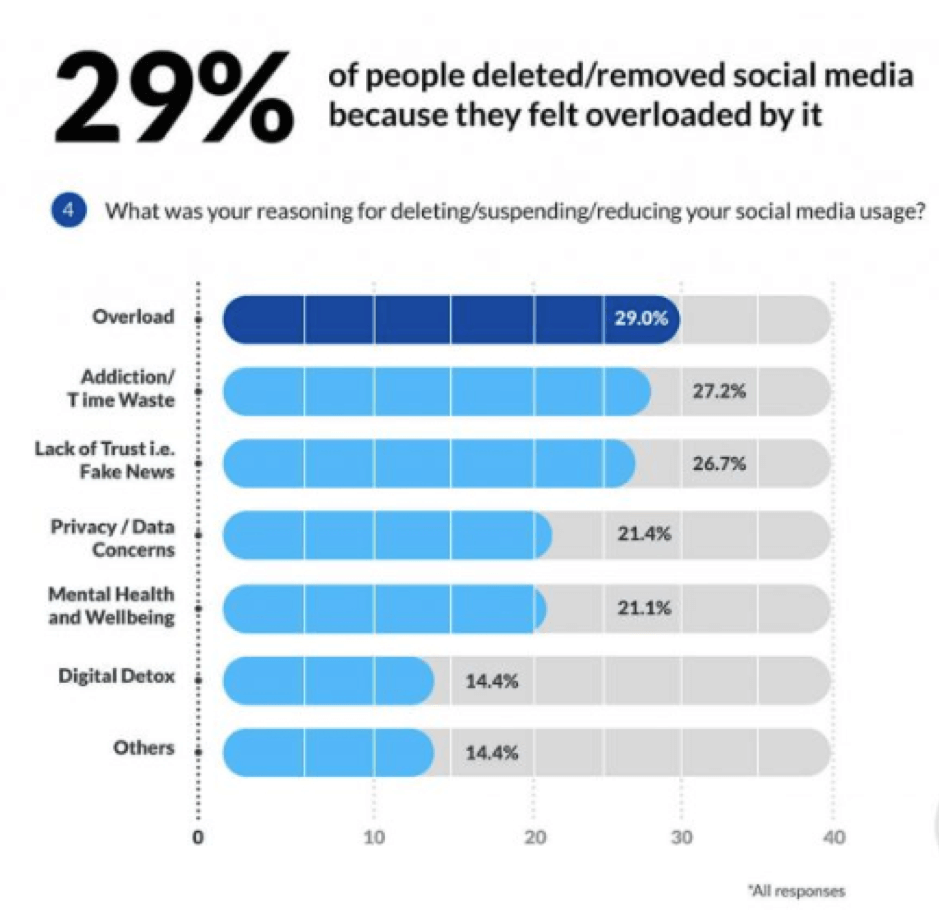
A big reason for this is that people now feel overloaded by social media, with the permeation of social media affecting their mental health and wellbeing. Others choose to detox because they don’t trust social media platforms, either due to issues like Fake News or because of privacy and data concerns.
“I think that this year, we’ll be seeing more of a change in the way social media users act online; I think that digital detox will become more prevalent this year, with many people trying to limit the amount of time they spend on social media.
“I also think that there will continue to be a big push towards making social media more private and secure for its users – this has been a big problem recently and many people are just realizing how truly dangerous a lack of online privacy can be. And these things, of course, will have a big impact on marketing too – brands and marketers need to be on top of these trends and act accordingly.”
Lilach Bullock – Content marketing and social media specialist.
This isn’t to say that social media will become void in terms of digital marketing, but marketers do need to understand the impacts it could have. When added to the issues that pay-to-play social media brings, more people taking on a digital detox (whether temporary or permanent) will impact reach and engagement of your posts. This can affect the results of any customer acquisition or brand awareness campaigns you launch across social media platforms.
Ultimately, it’s vital that you don’t start putting all your marketing eggs in the social media bucket. You need to ensure that enough budget and resource is still being given to other channels, including email marketing and search engine marketing. However, it’s also vital that you ensure that any social media presence you do have is as meaningful as possible. Your brand needs to offer more than memes – you need to deliver content that has a positive and memorable impact on your audience and that provides as much value as possible.
Building social media communities
A big part of meaningful and valuable experiences on social media is the way that brands engage with their audience. While sharing posts that you believe your target audience will enjoy is part of maintaining your social media presence, you also need to encourage and cultivate interactions that are more than a simple like or share.
There are a lot of brands out there who seemingly have large social media followings and yet, when you look more closely at individual posts, their engagement levels are almost non-existent. Those brands that are seeing more engagement from their followers are doing so by building communities around their content.

This isn’t to say that communities are a new concept, but they are being built by brands in different ways, which is paying off and will likely continue to do so as we head into 2020.
“While social communities aren’t a new concept, how brands build them is changing the way we interact with them. There are many brands, both B2C and B2B, that have massive followings with no real engagement. The bottom line is your online presence should expand your reach, to ultimately drive more conversions.
“For starters, it’s crucial to measure your efforts and stay in touch with your audience. Social media suites are a great way to see everything in one place, from post creation and distribution to monitoring and analytics. Figure out what’s working and what’s not – don’t be afraid to pivot and try something new!
- Encourage your team to create their own social presence to promote content and increase overall brand trust. This tactic leads to an authentic voice for your company,
- Twitter chats help create a strong sense of community through content, bringing thought leaders from all areas together in a real-time conversation. It gives your brand the perfect opportunity to engage directly with current and potential customers.
“More than ever before, potential buyers want to hear from current customers – so give them a place to do just that.”
Bridget Poetker – Senior Content Marketing Specialist at G2
Building social media communities away from your profiles is just the start, after all, creating a group and having people join is no guarantee that they will engage. You also need to create content that gets them talking, encourages conversations and cultivates that feeling of community. Doing so can keep people engaged with your brand but also bring in new leads and customers while also adding a human, personalized element to your brand.
“I believe that the days of merely posting content and people showing up to engage are slowly coming to an end as pay-to-play social media becomes more and more prevalent with every social network over time. As a company, you’re already at a disadvantage, which is why it will become more important than ever to actually engage with your community.
“I’m not talking about engagement so that your content shows up better in the algorithm, but actually thanking those people in your community not only when they comment or engage with your content but actually proactively reaching out to them like a social media user would reach out to a friend. If your business wants to survive in organic social media in 2020, I believe that this sort of humanization of your brand will be necessary.”
Neal Schaffer – Leading Global Educator and effective implementer of social media strategy for business.
Social media influencers and word-of-mouth marketing
One benefit of building social media communities is the fact that they help with word-of-mouth marketing, which is another big social media marketing trend for 2020. Communities allow you to engage with nano or micro-influencers who are already advocates of your brand in order to get them to share honest views and experiences of your products or services.
We all know that influencers have been around for a while and they have now become an expected part of the social media experience. They can offer great benefits for brands, including a relatively high earned media value, especially now that Instagram usage is continuing to grow at an elevated rate.
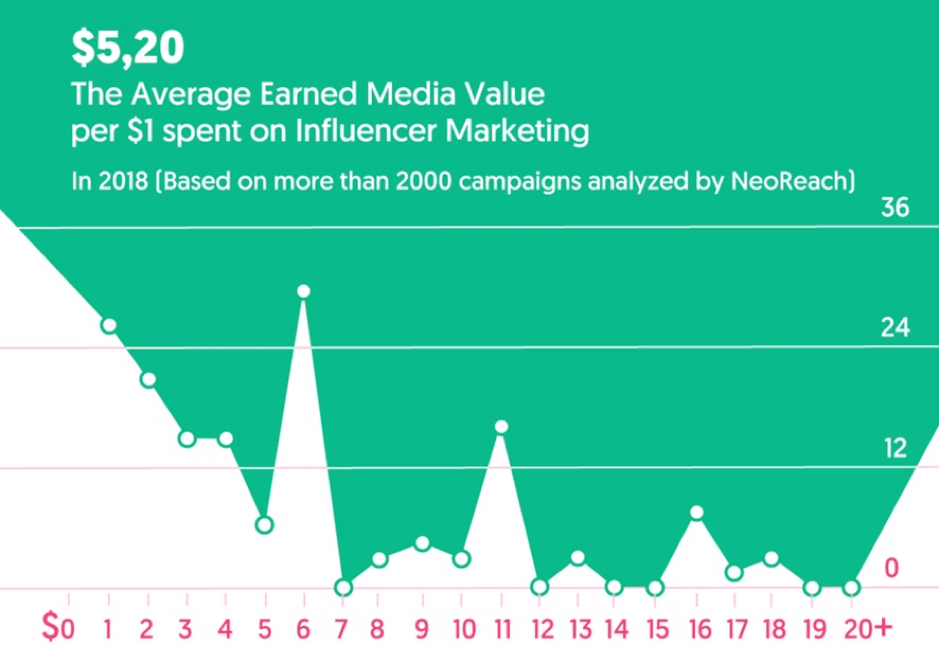
However, many types of influencers are no longer trusted by consumers. Big influencers are not only expensive for brands, they no longer have the impact that they used to because they are seen as disingenuous. In fact, 61% of consumers will trust the recommendations of friends and family over celebrity endorsements because they are more likely to be honest.
In comparison, smaller influencers, such as those who are likely to be part of your communities, tend to have better relationships with their followers, which means they benefit from a higher level of trust. This can lead to more engagement at a lower cost, as well as increased trust in a brand that is more likely to culminate in conversion.
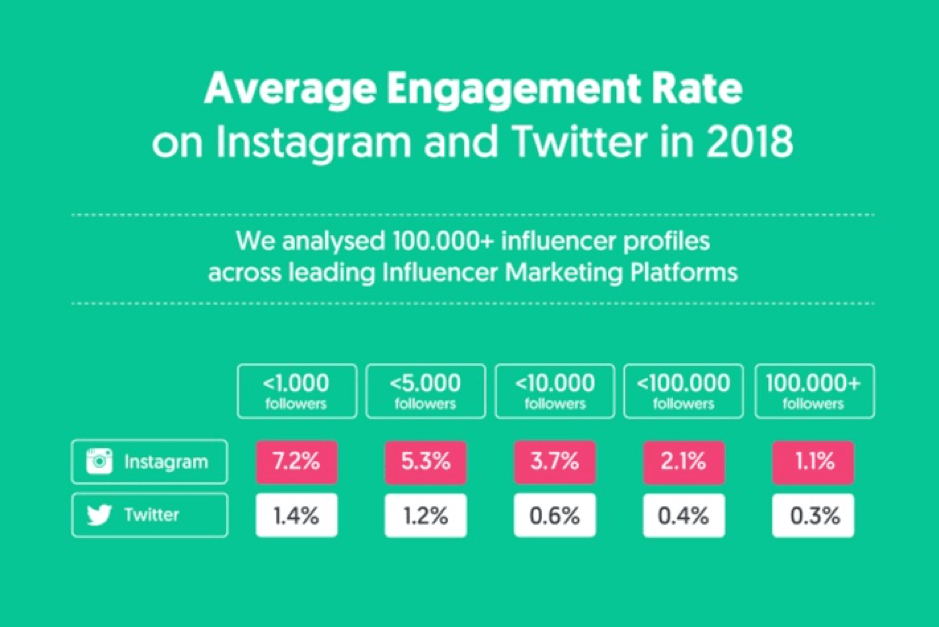
“A good reason to follow my advice on social media communities is that this will also make it much easier for your brand to engage with influencers in 2020. This obviously is the other way to incite Word of Mouth marketing on social media when organic social media for businesses is pretty much dead.
“Now I’m not talking about spending thousands of dollars and reaching out to celebrities who are promoting one brand today and another brand tomorrow. I’m talking about authentically engaging with those in your community who are already following you and are already nano if not micro-influencers and finding a way to collaborate with them.
“I am so passionate about this subject that it is going to be the focal point of my next book, Age of Influence, which publishes in March of 2020, but needless to say I hope that marketers in 2020 will realize that social media is not just a place to market to people, but really is the ultimate forum for you to find and collaborate with a variety of social media users of varying influence that can help push your marketing objectives forward.”
Neal Schaffer – Leading Global Educator and effective implementer of social media strategy for business.
Taking on nano or micro-influencers as brand ambassadors means that they can share posts about your brand but also engage in conversions with their highly engaged following or others within communities. It is these conversations that are more likely to influence buying decisions and help build trust in your company.
This type of marketing creates positive brand sentiment, gets people talking about your brand and provides more insights into consumers’ buying behaviour and pain points. All of this better enables you to create a genuine experience for your audience.
The rise of alternative platforms
Facebook, Twitter and Instagram tend to be the core platforms used by B2C brands, with LinkedIn also being vital for B2B companies. However, many users are growing fatigued with these core platforms while brands have to fight harder than ever before to achieve good levels of organic reach and engagement.
While Twitter has seen growth so far this year, its active user numbers have declined from it’s all-time 2017 high. Similarly, Facebook has seen a huge drop in users – especially younger users – over the last two years, with younger audiences opting to spend time on other platforms. Combined with the increasing pay-to-play format of social media channels, this means that brands aren’t seeing the results on these platforms that they previously did.
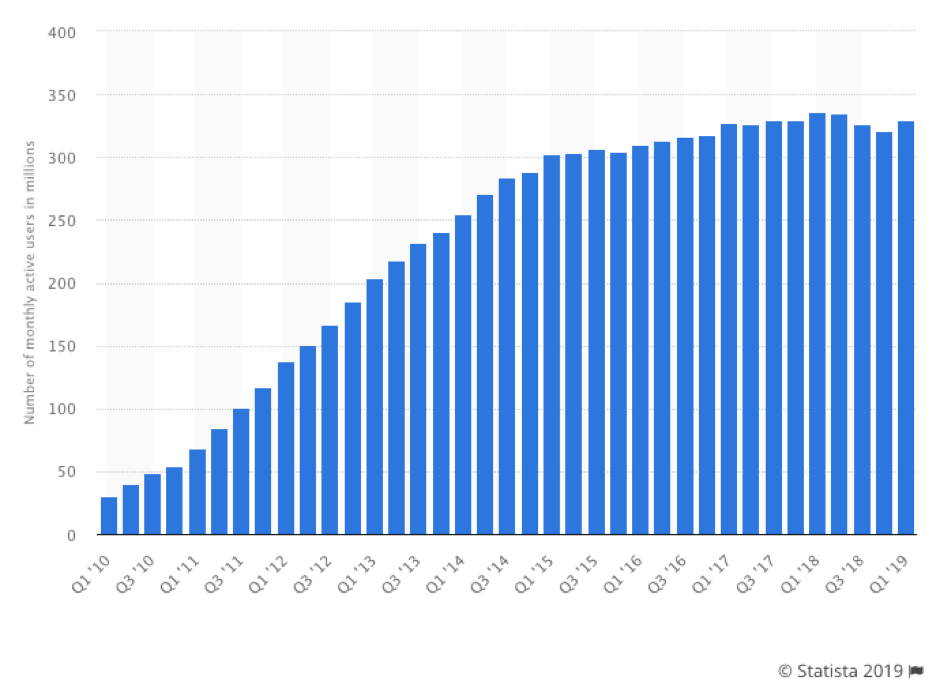
[Average monthly Twitter users by year]
One social media platform that is becoming a go-to, especially for younger generations, is TikTok. While the app was launched in 2016, its popularity has grown fairly recently, with 2019 seeing a huge number of users flock to the platform. It now has around 500 million monthly active users worldwide and registered more than 1.1 billion installs as of March 2019.
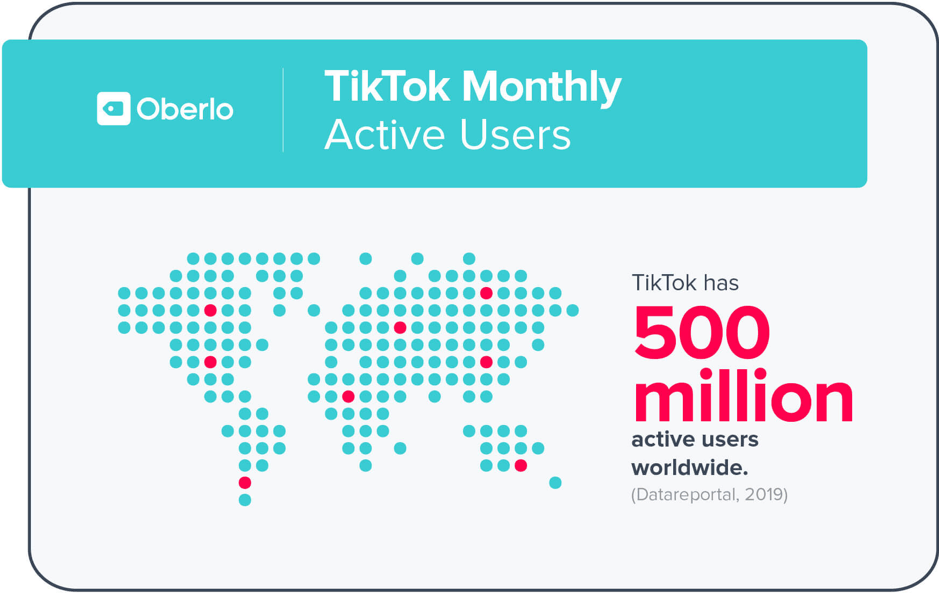
While TikTok is unlikely to be the best option for B2B brands, B2C companies with a younger target audience (41% of TikTok users are aged between 16 and 24) could find it to be a great platform to encourage engagement with users who are stepping away from more traditional social media platforms.
As well as TikTok, a good platform to invest in for those looking to encourage e-commerce sales through social media could be Pinterest. Although Pinterest is far from new on the scene, it has experienced a recent resurgence, meaning it is now used for more than just saving recipes or getting decorating inspiration.
Pinterest has found that it fits well into the e-commerce space and has an audience that is engaged with the idea of buying products they see on the platform. In fact, 75% of Pinterest users say they are “very interested” in new products compared to just 55% of people on other social media platforms.
This is likely why retail brands are finding success on the platform, with them reporting 2x higher returns on ad spend from the platform than other forms of social media and a 1.3x higher return than traditional search.
“Since Instagram as an e-commerce platform is getting harder to gain customers from, marketers will highly likely move to Pinterest. Pinterest now resembles Instagram when the latter emerged. No obtrusive ads, user-friendly search engine, and no fake influencers. More than 250 million people use Pinterest every month, and this number will increase.
“Speaking of TikTok, this platform keeps growing very rapidly. Marketers and business owners whose target audience are teenagers and young people should definitely consider TikTok as a winning marketing platform. TikTok is already an attractive platform for YouTube, Instagram, and Twitch bloggers since it’s effortless and fun to make videos and gain fame there.”
Klara Alexeeva, Content editor at combin.com
Utilizing these alternative platforms allows you to engage with an audience who may not be on Instagram, Facebook or Twitter, as well as providing you with different ways to share your content. This could help deliver better results and shape your future social media marketing strategy.
Social media as customer service
Customer service is always going to be a vital aspect of providing a good customer experience, but in the digital age, the customer service you offer is a lot more visible to everyone online. As well as online customer reviews, customer complaints and issues are easier to find than ever before due to the fact that a lot of them are shared on social media.
Over a quarter (28%) of consumers have used social media to communicate with a company in the last year, a trend that is likely to increase due to the fact that more than 30% said it is a convenient contact method and around 23% believe it is a good way to get 24-hour service.
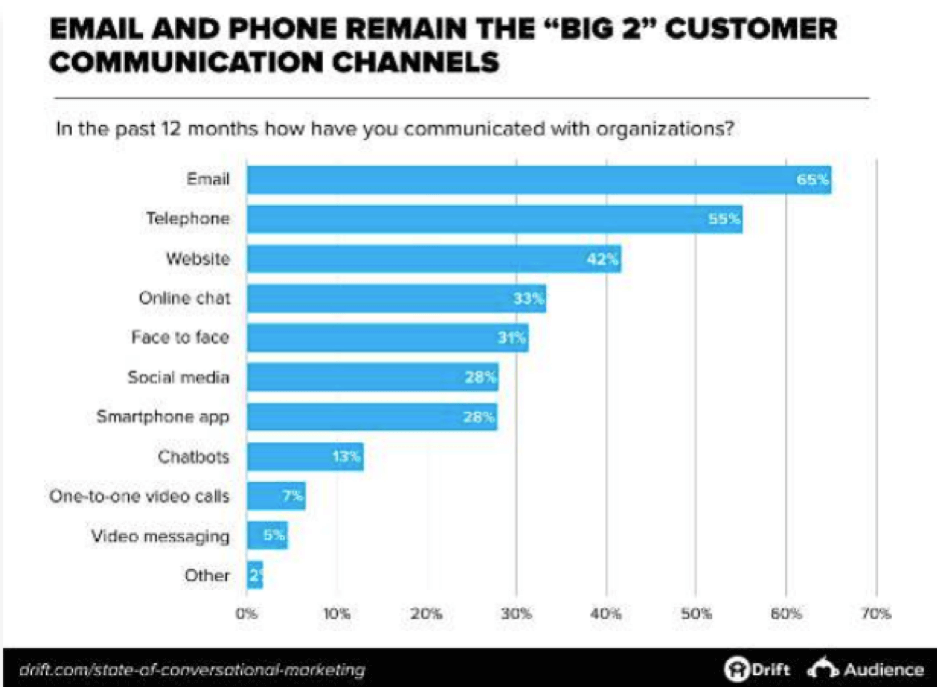
Because social media is viewed as being so convenient, it is expected that brands will find it easy to use as a method of customer service. As a result, most people expect brands to respond to a question or complaint on social media on the same day, with 37% wanting a response in under 30 minutes. Only 6% don’t expect a response at all, while 31% want one in under 2 hours and a further 26% want to hear back within four hours, showing that the expectations for good customer service on social media are high.
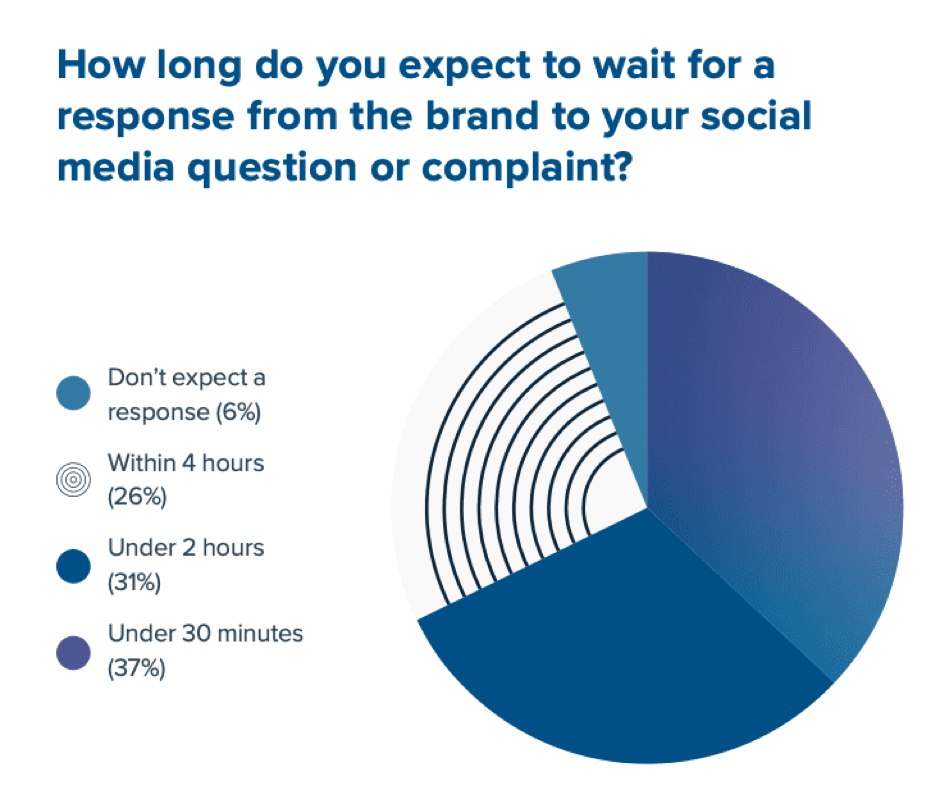
This is why social media as a form of customer service is going to be a big trend for 2020, especially with so many brands looking to create online communities.
“In the same way that social media became a real alternative for an actual social life, it is rapidly evolving as a customer service tool. Companies have taken notice of this, and offer more and more customer service through social media. Brands have developed significantly more active social accounts, all for the sake of interacting with the massive user base spread across social media channels.”
Dmitrii Kustov – Internet Marketing Director at Regex SEO
As well as offering an easy way to speak to customers and quickly deal with issues – especially as everyone is so connected to social media – this form of customer service offers benefits for brands. Answering a customer complaint can increase customer advocacy by as much as 25%, meaning that responding to complaints can help create loyal customers. However, you also need to remember that failing to respond to a complaint can decrease customer advocacy by 50%, so a social media customer service strategy is required in order to ensure all members of your customer care team are following the same steps, especially as more customers are likely to be contacting you through social media over the next year.
Telling Stories on social
Since the launch of Snapchat, other social media platforms have rushed to add the Stories format to their offering. The result has been huge growth in the usage of this format for Instagram in particular, which as of January 2019, boasts 500 million daily active Stories users across the globe.
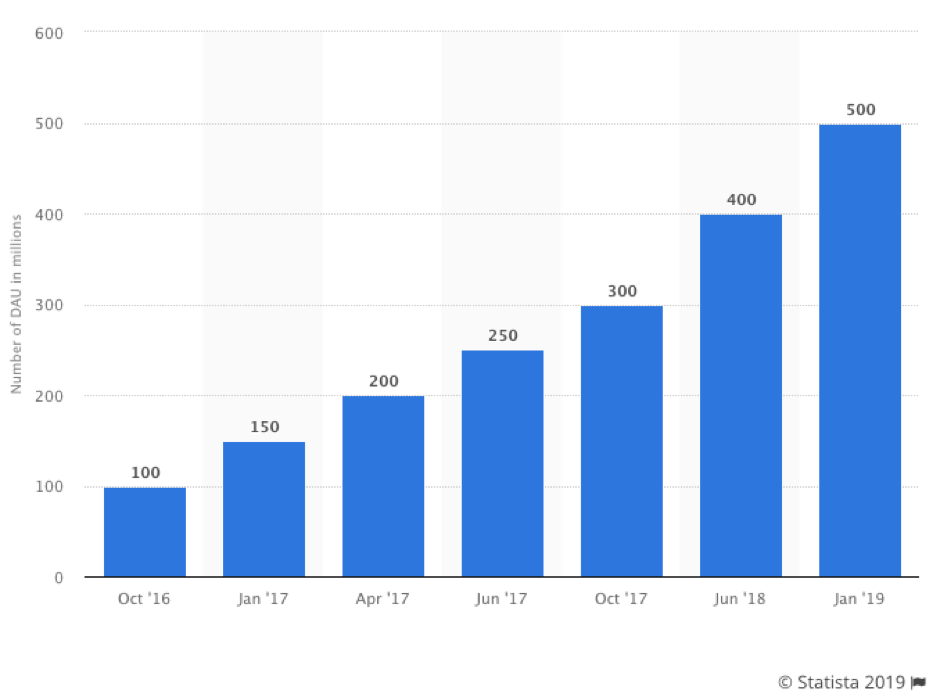
[Daily active Instagram Stories users]
Stories offer a different experience to feed-based sharing due to the fact that they are visual and designed to be both created and consumed in-the-moment, rather than shared to a feed that will remain visible. There’s a lot of room for experimentation, tongue-in-cheek posts and fun, which makes Stories highly engaging, and it is one of the likely reasons as to why Stories had a growth rate that was 15x the rate of Feeds in 2017.
However, the growth in Stories isn’t just among consumers, businesses are also utilizing this social media tool for marketing purposes. According to Hootsuite’s 2019 Social Trends Survey, 64% of marketers have either already implanted Instagram Stories into their social media strategy or are aiming to do so in the next 12 months.
On average, brands are posting Stories on around seven days a month, averaging out to one Story every four days. Brands with a following of 100,000 or more share Stories more regularly (every two days), likely due to the fact that they can benefit from a greater range of Stories features – such as adding a link to their posts on Instagram.
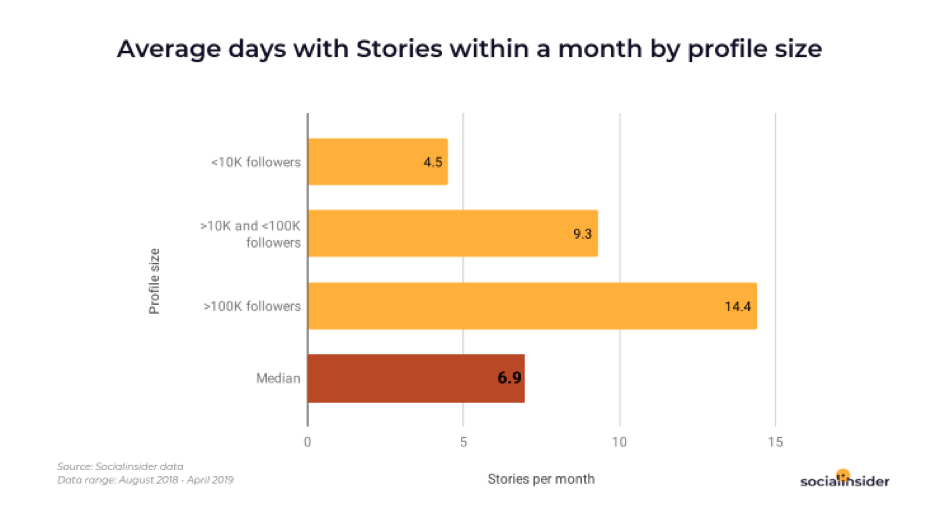
Brands are also advertising more via Stories, with 45% of Instagram ad spend being on Stories, suggesting that brands are seeing better results with the more direct format being offered by Stories.
“If you regularly use social media, it will not come as a surprise that Instagram Stories’ popularity will further increase in 2020. Battenhall conducted research that found that 98% of Instagram accounts use Stories, while 400 million users watch Instagram Stories on a daily basis.
“It appears that big brands are favouring Instagram Stories for their advertising and marketing, in fact, one in three of the most-viewed Stories are from businesses. However, the question is why are they so popular?
- Instagram Stories are more authentic than traditional Instagram posts that allow for heavy editing and altering.
- The content is only available for 24hrs, therefore, it is current and will not become outdated.
- Consumers want live updates and real-time content. Instagram Stories are normally the most up-to-date content a business can offer a consumer.
- Through Instagram Stories, you can share other people’s Instagram posts. This function allows people to connect easily with other accounts and businesses.
“I think that brands are going to begin to use Instagram Stories to push consumers to IGTV, to create more long-form content for their organizations. Alternatively, perhaps towards social e-commerce, where brands will begin selling their products via Instagram Stories.”
Maisie Tomlinson – marketing coordinator for Penguins Events and Incentives.
Stories aren’t going to be a suitable option for every brand out there, but with them being so engaging and seeing an increased use that will likely lead consumers to expect brands they follow to create Stories, it is worth assessing if and how you can utilize them. As Instagram sees more businesses use Stories, the platform will also likely release more features designed for brands, which could make the format more accessible for a broader range of companies.


